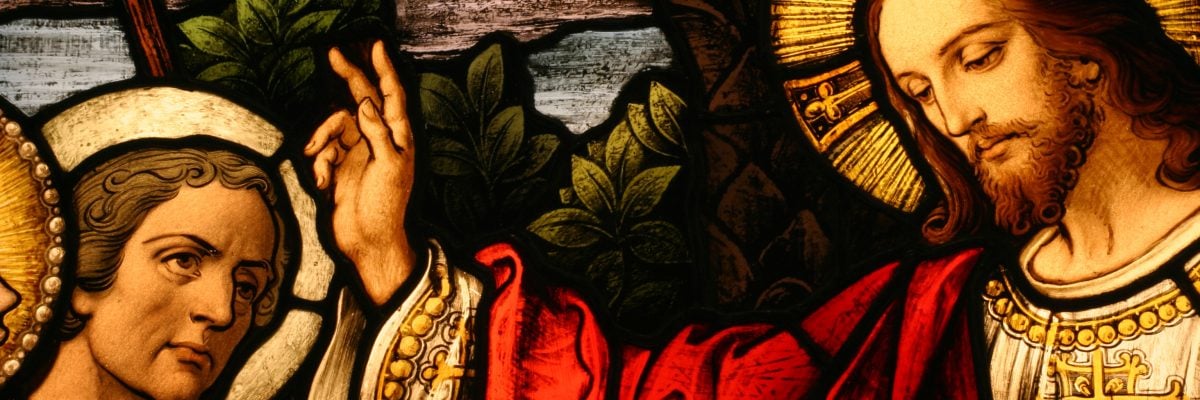
Salon.com recently published an article by former Evangelical-turned-freethinker Valerie Tarico titled 9 things you think you know about Jesus that are probably wrong.
There’s nothing particularly groundbreaking contained in her arguments, but they’ve been making the rounds in social media, and therefore worthy of a response.
Below are each of the nine points, and how to answer if you find yourself confronted with them.
1. Jesus was married, not single.
This tired old claim has been refuted more times than the earth has revolved around the sun, but Tarico backs it up with a rather recent discovery:
When an ancient papyrus scrap was found in 2014 referring to the wife of Jesus, some Catholics and Evangelicals were scandalized. But unlike the Catholic Church, Jews have no tradition of celibacy among religious leaders.
The papyrus she refers to is known as The Gospel of Jesus’ Wife. Catholics and Evangelicals might have been scandalized by this if it was authentic, but it’s not. Owen Jarus of Livescience explains that “a growing number of scholars have denounced the business card-sized papyrus as a fake.”
Furthermore, the fact that ancient Jews had no tradition of celibacy among their religious leaders is irrelevant. Jesus was often at odds with the religious leaders of his time, and it is precisely because of him that the Catholic Church has a tradition of clerical celibacy. In Matthew 19, the disciples proclaim to Jesus that it is better not to marry, to which he responds, “He who is able to accept it, let him accept it” (Mt. 19:10-12).
2. Jesus had cropped hair, not long.
Tarico claims the traditional imagery of a long-haired Jesus is most certainly wrong. As backup, she refers to 1 Corinthians 11:14 where Paul writes, “Does not even nature itself teach you that if a man has long hair, it is a dishonor to him?”
How long is long? To understand Paul’s words here, we need to evaluate them in their cultural context.
When I was in high school, I remember seeing old pictures of the Beatles on their album covers from my mom’s collection. She told me that the length of their hair was considered long at that time. In those days, I laughed and thought, “That’s not long!” It was the late 1980’s and my hair was down to the middle of my back. What is considered long depends entirely on cultural context.
As further evidence for this claim, Tarico points to an ancient Roman depiction of Jewish men with short hair. If you look closely at the picture, two of the men have shoulder-length hair. What’s even more telling is that not a single one of them has a beard, but we know Jewish men of that time wore beards. It is more likely that the men are depicted this way because that was the cultural norm among first-century Romans, and not because it was necessarily representative of Jewish practice in the area where Jesus lived.
3. Jesus was hung on a pole, not a cross.
Tarico points out that the Greek work “stauros,” which is translated into English as “cross,” can also refer to a number of other shapes. Fair enough. But she also claims that the early Christians may have adopted the shape of the cross because it echoed shapes used by pagan religions of the time.
I’m skeptical of any argument claiming early Christians borrowed this or that custom from a contemporary pagan religion. In my own research I have found these supposed connections to be tenuous or even outright bogus. We know that some people in first-century Rome were crucified the same way Jesus has traditionally been depicted (cf. Seneca the Younger, “To Marcia on Consolation”, in Moral Essays, 6.20), so there is no good reason to believe that Christians adopted this motif. It’s more likely that the traditional account is the correct one.
Tarico’s argument is also popular among Jehovah’s Witnesses. My colleague Trent Horn has written a more detailed piece on this which you can read here.
4. Jesus was short, not tall.
Tarico points out that the typical Jewish male in the Roman Empire was just over five feet tall. Jesus is often depicted in traditional art being taller than the people around him.
This doesn’t mean he was a giant like Kim Jong Il’s super soldier. It just may have been that he was somewhat taller than the average Jew of his day. Either way, there is no evidence to support Tarico’s claim that Jesus must have been a short man.
5. Jesus was born in a house, not a stable.
Tarico writes:
The miraculous birth story of Jesus is a late, maybe second-century addition to the Bible, and it contains many fascinating mythic elements and peculiarities. But the idea that Jesus was born in a stable was added to the Christmas story even later. In the original narrative, Joseph and Mary probably would have stayed with relatives, and the phrase “no room for them in the inn (gr: kataluma)” is better translated “no room for them in the upper room.”
She is correct that “kataluma” is properly translated as “upper room.” It may not have been a stable in the sense that it was a separate structure used for housing animals only, but it was an area where animals were kept and cared for. As Pope Emeritus Benedict XVI explains:
Mary laid her newborn child in a manger (cf. Lk 2:7). From this detail it has been correctly deduced that Jesus was born in a stable, in an inhospitable—one might even say unworthy—place (Jesus of Nazareth, The Infancy Narratives, pg 67).
Tarico is wrong, however, when she claims to know that the birth narrative is a late second-century addition to Luke’s Gospel. Luke 2:7 (the verse in question) can be found in Payrus 4, which dates from the early to middle second century. It’s safe to assume that this fragment was copied from an earlier manuscript, and there is no compelling evidence that the narrative was not part of the original.
6. He was named Joshua, not Jesus.
Tarico points out that Joshua and Jesus are the same name translated differently in English to distinguish between the Joshua of the Old Testament and the Jesus of the New Testament. But both names are Anglicizations of Yeshua. So he wasn’t technically named Joshua or Jesus.
Wikipedia has an explanation of the etymology of the name `Jesus.’ You can read it here.
7. The number of apostles (12) comes from astrology, not history.
Tarico claims that the number of apostles was probably chosen due to pagan influence:
Astrotheology or star worship preceded the Hebrew religion, and shaped both the Bible and world religions more broadly. One might point to the 12 Olympian gods or 12 sons of Odin, or 12 days of Christmas or 12 “legitimate” successors to the prophet Mohammed.
The only evidence we have to indicate why Jesus chose twelve men to be the first apostles is related to the Twelve Tribes of Israel without reference to astrology (cf. Mt. 19:28). Furthermore, the number twelve is significant in many cultures, but that doesn’t mean that any one borrowed it from another. For example, the Twelve Nid?nas in Buddhism identify the origins of suffering and ignorance, yet most scholars would not point to any causal relationship between early Buddhism and the pagan religions of the Romans (cf. Ronald H. Nash, The Gospel and the Greeks, p. 168).
8. The prophecies about Jesus were recalled, not foretold.
Tarico’s claim here is that the Gospel writers would have been intimately familiar with the prophecies in the Old Testament, and so they could have shaped their stories around earlier predictions. I don’t believe the authors shaped their stories around the Old Testament prophecies, but I do believe many of the prophecies were recalled by the authors to demonstrate how they had been fulfilled.
There are other prophecies of Jesus that did come to pass which did not appear in the Old Testament. For example, Jesus foretold the destruction of the Jewish temple. In 70 AD it came to pass. Some may argue this was also recalled by the Gospel writers, but this comes from a purely skeptical point of view that casts doubt on everything Jesus said. This brings us to Tarico’s final argument:
9. Some quotes are not from Jesus; others are uncertain.
Tarico takes a very skeptical approach to the sayings of Jesus in the Gospels. She explains, “no technology existed with which to record his teachings in real time, unless he wrote them down himself, which he didn’t.” It’s true that Jesus didn’t write anything down, but this should not be surprising given he lived in a primarily oral culture.
One passage she points to is the woman caught in adultery (John 8:1-11). It’s true that many scholars believe this passage was likely added to the text at a later time. Most modern Bibles place the passage in brackets and include a footnote explaining that it does not appear in the earliest manuscripts. But as Professor Michael barber explains, “It should be mentioned, however, that even many scholars who see the story as a secondary addition to the Gospel still believe that it relates a historical memory of Jesus.”
Regardless, this is not by itself a reason to doubt all (or even most) of the sayings attributed to Jesus in the Gospels.
Conclusion
In fairness, Tarico admits that these points are trivial—and they are. But her larger point is that she believes most of what we know about Jesus is probably wrong. As I’ve illustrated here, there are reasonable responses to every point she brings up.
If you are interested in reading more about the reliability of the Bible, we have a lot of great resources on this site. I also recommend The Sacred Page for discussions on the state of modern Biblical scholarship from a Catholic perspective.



